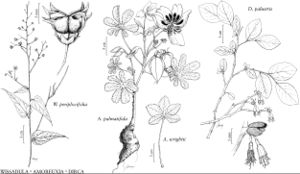Amoreuxia
in A. P. de Candolle and A. L. P. P. de Candolle, Prodr. 2: 638. 1825.
| Taxon | Illustrator ⠉ | |
|---|---|---|
 | Wissadula periplocifolia Amoreuxia wrightii Amoreuxia palmatifida Dirca palustris | Linny Heagy Linny Heagy Linny Heagy Linny Heagy |
Roots (xylopodia) thick, tuberous or woody. Stems to 60 cm, glabrous or hairy. Leaves long-petiolate; stipules inconspicuous, brown; blade suborbiculate to reniform, 5 or 7 (9) -lobed petals with 2 conspicuous red to purple marks at bases; stamens in 2 dimorphic sets, filaments of proximal set longer with cream to dark red anthers, filaments of distal set shorter with yellow or yellow-cream anthers; anthers 2-pored; ovary usually pubescent; style usually surpassing stamens. Capsules pendulous, oblong-obovoid or ovoid to ellipsoid. Seeds glabrous or pilose, hairs sometimes spinelike. x = 6.
Distribution
sw United States, Mexico, West Indies (Curaçao), Central America, South America (Colombia), South America (Peru)
Discussion
Species 4 (3 in the flora).
The one species of Amoreuxia not in the flora area is A. malvifolia, which occurs in the Mexican states of Chihuahua and Durango.
Most of the species of Amoreuxia have been important food plants for indigenous tribes of northern Mexico and southwestern United States (W. C. Hodgson 2001; H. H. Poppendieck 1980).
Amoreuxia is usually characterized as herbaceous, despite having slightly woody aerial parts and a woody subterranean organ. The woody subterranean organs, known as xylopodia, are made up of rootlike stems. The roots originate from below the xylopodium. They are similar in size and shape to thick carrots; they are brownish outside and creamy white inside.
The species of Amoreuxia are very similar. To separate them, leaf, fruit, and seed characters can generally be used reliably; flower characters appear to be relatively uniform across species (R. McVaugh 2001). According to H. H. Poppendieck (1980), it is probable that Amoreuxia is a tropical taxon that moved northward into Central America and southern North America in relatively recent times with a secondary center of diversification in northern Mexico. Poppendieck hypothesized that the scattered and apparently relictual distribution of A. palmatifida is evidence that it may be most closely related to the primitive species of the genus from which all the currently known species may have evolved. This hypothesis is not strongly supported by the interesting disjunct distributions of A. wrightii in Peru and in Curaçao and the molecular clock data which indicate an earlier divergence for A. wrightii (S. B. Johnson-Fulton 2014).
The flowers of Amoreuxia are very bright and easy to spot in the field; because they open early and usually close by late morning or early afternoon, it is best to search for this genus in the morning.
Selected References
None.
Lower Taxa
Key
| 1 | Leaf blades 5(7)-lobed, lobes subrhombic, apex rounded to acute, tooth of central lobe apex most distal; seeds glabrous. | Amoreuxia wrightii |
| 1 | Leaf blades 7(9)-lobed, lobes obovate, spatulate, or linear, apex usually truncate to slightly obtuse, sometimes emarginate, 3–5 teeth of central lobe apex usually equally distal; seeds sparsely pilose or hispid, hairs sometimes spinelike | > 2 |
| 2 | Capsules broadly ovoid, 2–4 cm; seeds reniform; ovaries densely short-haired lanate to tomentose or puberulent; stems and petioles subglabrous to sparsely lanulose-puberulent. | Amoreuxia palmatifida |
| 2 | Capsules ellipsoid, 5–8 cm; seeds globose; ovaries densely silky-pilose; stems and petioles pilose (hairs wavy, slightly tangled). | Amoreuxia gonzalezii |